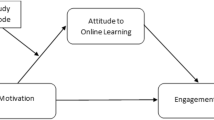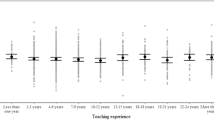Abstract
This paper reports the use of quantitative and qualitative measures of university student learning during teaching in psychiatry. Concept mapping, pre-and post test scores and performance in written assignments were used to measure the quality of change in personal understanding and to show the ways that the knowledge-targets of the course were achieved. The data show that: (1) Concept mapping can be used to explore personal understanding because it facilitates discrete statements of meaning. (2) These personal statements can be compared through time to assess change. (3) Specific criteria can be used to measure the quality of the change from one statement to another so that the different qualities of change that occur can be made-visible in the course of teaching. The approach is discussed in the broader context of learning theory and teaching practice. We show in particular, that prior-knowledge is an important determinant of learning because it affects the sense that can be made of taught material.










Similar content being viewed by others
References
Ausubel, D. P. (1963). The psychology of meaningful verbal learning. New York: Grune and Stratton.
Ausubel, D. P. (1968). Educational psychology: A cognitive view. New York: Holt, Rinehart and Winston.
Ausubel, D. P. (2000). The acquisition and retention of knowledge: A cognitive view. Dordrecht: Kluwer Academic Publishers.
Ausubel, D. P., Novak, J. D., & Hanessan, H. (1978). Educational psychology: A cognitive view. New York: Holt, Rinehart and Winston.
Biggs, J. (1993). What do inventories of students’ learning processes really measure? A theoretical review and clarification. British Journal of Educational Psychology, 63, 3–19.
Biggs, J. (2003). Teaching for quality learning at University: What the student does. Buckingham: Society for Research into Higher Education & Open University Press.
Brown, S., & Knight, P. (1994). Assessing learning in higher education. London: Kogan Page.
Buzan, T., & Buzan, B. (2000). The concept map book. London: BBC Worldwide Ltd.
Chomsky, N. (1965). Aspects of the theory of syntax. Cambridge: MIT Press.
Entwistle, N., McCune, V., & Walker, P. (2001). Conceptions, styles and approaches within higher education: Analytic abstractions, everyday experience. In R. J. Sternberg & L.-F. Zhang (Eds.), Perspectives on thinking, learning and cognitive styles (pp. 103–136). London: Lawrence Erlbaum.
Entwistle, N. J., & McCune, V. (2004). The conceptual basis of study strategy inventories. Educational Psychology Review, 16, 325–345.
Entwistle, N. J., Meyer, J. H. F., & Tait, H. (1991). Student failure: disintegrated perceptions of studying and the learning environment. Higher Education, 21, 249–261.
Entwistle, N. J., & Smith, C. A. (2002). Personal understanding and target understanding: mapping influences on the outcomes of learning. British Journal of Educational Psychology, 72, 321–342.
Entwistle, N. J., & Tait, H. (1994). Approaches to studying and preferences for teaching in higher education. Instructional Evaluation and Faculty Development, 14, 2–10.
Fisher, K. M. (2000). Overview of knowledge mapping. In K. M. Fisher, J. H. Wandersee, & D. E. Moody (Eds.), Mapping biology knowledge (pp. 5–23). Dordrecht: Kluwer Academic Publishers.
Hay, D. B. (2007). Using concept maps to measure deep, surface and non-learning outcomes. Studies in Higher Education, 32(1), 39–57.
Hay, D. B., & Kinchin, I. M. (2006). Using concept maps to reveal conceptual typologies. Education and Training, 48, 79–83.
Hay, D. B., & Kinchin, I. M. (2007). Using concept mapping to make concrete measures of learning quality in higher education. Proceedings of the European Learning Styles Conference, Dublin, Ireland, June 11–14, 2007.
Hay, D. B., Kehoe, C., Miquel, M. E., Kinchin, I. M., Hatzapinagos, S., Keevil, S. F., & Lygo-Baker, S. (in press). Measuring the quality of e-learning. British Journal of Educational Technology.
Hay, D. B., Kinchin, I. M., & Lygo-Baker, S. (in press). Making learning visible: the role of concept mapping in higher education. Studies in Higher Education, 33(3).
Jarvis, P. (1992). Paradoxes of learning. San Francisco: Jossey Bass.
Jarvis, P. (1998). From practice to theory. San Francisco: Jossey Bass.
Jarvis, P. (2006). Towards a comprehensive theory of human learning: Lifelong learning and the learning society, vol. 1. London & New York: Routledge.
Jarvis, P., Holford, J., & Griffin, C. (1998). The theory and practice of learning. London: Kogan Page.
Kember, D. (1996). The intention to both memorise and understand: another approach to learning? Higher Education, 31, 341–351.
Kember, D. (2000). Misconceptions about the learning approaches, motivation and study practices of Asian students. Higher Education, 40(1), 99–121.
Kinchin, I. M., & Alias, M. (2005). Exploiting variations in concept mapping morphology as a lesson planning tool for trainee teachers in higher education. Journal of In-service Education, 31, 569–591.
Kinchin, I. M., & Hay, D. B. (2007). The myth of the research-led teacher. Teachers and Teaching: Theory and Practice, 33(1), 43–61.
Kinchin, I. M., Hay, D. B., & Adams, A. (2000). How a qualitative approach to concept map analysis can be used to aid learning by illustrating patterns of conceptual development. Educational Research, 42(1), 43–57.
Kinchin, I. M., Lygo-Baker, S., & Hay, D. B. (in press). Universities as centers of non-learning. Studies in Higher Education, 33(1).
Kolb, D., & Fry, R. (1975). Towards and applied theory of experiential learning. In C. L. Cooper (Ed.), Theories of group processes (pp. 103–136). London: J. Wiley and Sons.
Lauirillard, D. (2002). Rethinking university teaching: A framework for the effective use of learning technologies (second ed.). London and New York: Routledge/Falmer.
Marton, F. (1981). Phenomenography—describing conceptions of the world around us. Instructional Science, 10, 177–200.
Marton, F. (1986). Phenomenography—a research approach to investigating different understandings of reality. Journal of Thought, 21(3), 28–49.
Marton, F., & Säljö, R. (1976). On qualitative differences in learning: I. Outcome and process. British Journal of Educational Psychology, 46, 115–127.
Marton, F., & Säljö, R. (1984). Approaches to learning. In F. Marton, D. Hounsell, & N. Entwistle (Eds.), The experience of learning (pp. 36–55). Edinburgh: Scottish Academic Press.
Meyer, J., & Land, R. (2003). Threshold concepts and troublesome knowledge: linkages to ways of thinking and practicing within the disciplines. (Occasional Report 4, Enhancing Teaching and learning environments in undergraduate courses, Edinburgh; ETL Project).
Meyer, J., & Land, R. (2005). Overcoming barriers to student understanding. London: RoutledgeFalmer.
Mintzes, J. J., Wandersee, J. H., & Novak, J. D. (1997). Meaningful learning in science; the human constructivist perspective. In G. D. Phye (Ed.), Handbook of academic learning (pp. 405–447). Orlando: Academic Press.
Nicholls, G. (2002). Developing teaching and learning in higher education. London: RoutledgeFalmer.
Novak, J. D. (1998). Learning creating and using knowledge: concept maps as facilitative tools in schools and corporations. Mahaw: New Jersey & London’ Lawrence Erlbaum.
Novak, J. D., & Gowin, D. B. (1984). Learning how to learn. Cambridge: Cambridge University Press.
Novak, J. D., & Musonda, D. (1991). A twelve-year longitudinal study of science concept learning. American Educational Research Journal, 28(1), 117–153.
Novak, J. D., & Symington, D. J. (1982). Concept mapping for curriculum development. Victoria Institute for Educational Research Bulletin, 43, 3–11.
Perkins, D. (2006). Constructivism and troublesome knowledge. In Meyer, J. H. F., & Land, R. (Eds.), Overcoming barriers to student understanding: threshold concepts and troublesome knowledge (pp. 33–47). London: Routledge.
Prosser, M., & Trigwell, K. (1999). Understanding learning and teaching: the experience in higher education. Buckingham: Open University Press.
Ramsden, P. (2002). Learning to teach in higher education. London & New York: Routledge.
Rowntree, D. (1987). Assessing Students: How Shall We Know Them? London: Kogan Page.
Säljö, R. (1975). Qualitative differences in learning as a function of the learner’s conception of the task. Gothenburg: Acta Universitatis Gothoburgensis.
Scheja, M. (2006). Delayed understanding and staying in phase: Student’s perceptions of their study situation. Higher Education, 52, 421–445.
Acknowledgements
The work reported here was funded by a grant for the research of pedagogy from the Society for Educational Studies.
Author information
Authors and Affiliations
Corresponding author
Rights and permissions
About this article
Cite this article
Hay, D.B., Wells, H. & Kinchin, I.M. Quantitative and qualitative measures of student learning at university level. High Educ 56, 221–239 (2008). https://doi.org/10.1007/s10734-007-9099-8
Received:
Accepted:
Published:
Issue Date:
DOI: https://doi.org/10.1007/s10734-007-9099-8




